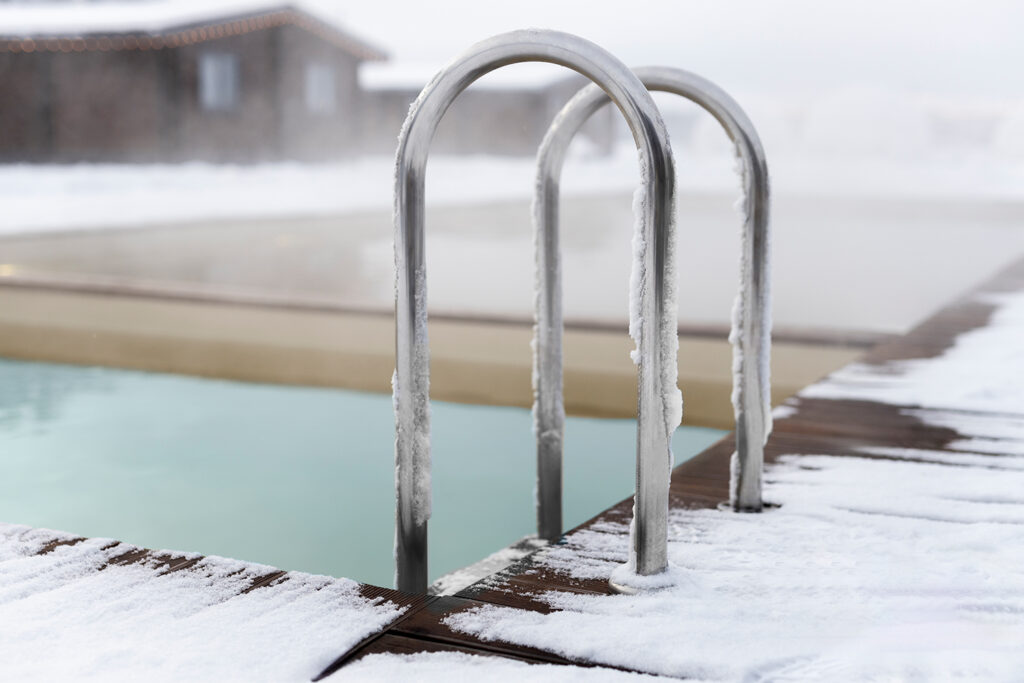As the leaves begin to change color and fall, it’s important to consider how to prepare your pool for winter. Winterizing your pool is an important step to ensure it stays in good condition during the colder months.
This process goes beyond superficial acquaintance. Protecting your pool from freezing temperatures, potential damage, and maintaining water quality requires a comprehensive approach. Also, familiarize yourself with the pool building code in your area to avoid any problems.

Rediscover your pool for winter
Start by assessing the current condition of your pool. Check for repairs that may be needed, such as cracks or leaks, and address these issues before the cold starts. Ensuring that your pool is structurally sound before winterization not only protects your investment, but also makes it much easier to reopen your pool come spring.
Water chemistry balance for winter
Before you cover your pool, it is essential to balance the water chemistry. This includes regulating pH, alkalinity and calcium hardness levels. Balanced water protects against corrosion and scale, which can damage your pool in the winter. And this is no more difficult to understand than sprinkler systems.
These preliminary steps are essential to protecting your pool and will ensure that when the warm weather returns, your pool is clean, clear and ready to enjoy.
According to a reputable Aurora landscaping company, you should aim for a pH level between 7.2 and 7.6, alkalinity between 80-120 ppm and calcium hardness around 200-400 ppm.
Clean the pool thoroughly for winter
A clean pool is less likely to develop algae and other problems during the winter. Brush the walls, vacuum the floor and wash the surface to remove debris. Pay special attention to nooks and crannies where algae tends to form.
This step involves paying close attention to every part of your pool to ensure it stays pristine during the colder months.
- Brush the walls – use a stiff pool brush to clean the sides. This prevents the build-up of algae and limescale.
- Vacuum the pool floor – Vacuum the pool floor regularly to remove dirt, leaves and other debris.
- Wash the surface – use a squeegee to remove leaves, insects and floating debris.
- Focus on corners and crevices – these areas are prone to algae and should be carefully cleaned.
- Cleaning products – use chlorine-based cleaners for surfaces, algaecide to prevent algae growth, and tile cleaners for tiled areas.
- By systematically cleaning every part of the pool and using the right cleaning products, you will not only maintain its beauty, but also ensure its health and longevity. When the pool reopens in the warmer seasons, this effort will result in an attractive pool, clean and ready to be enjoyed without the added hassle.
Lower the water level and lower the evacuation equipment
Lower the water level below the skimmer line to prevent freeze damage. Also, drain water from your pool equipment, including pumps, filters, heaters and chlorinators, to prevent cracking due to ice expansion.
This step is all about protecting the pool infrastructure from the harsh elements of winter.
- Lower Water Level – Lower the water to a level below the skimmer line. This is very important to prevent damage from freezing water.
- Drain the pump – make sure all the water is out of the pump to prevent internal ice expansion and damage.
- Drain the filter – whether it’s a sand, cartridge or DE filter, make sure it’s completely drained.
- Drain the heater – Remove all water from the heater to prevent internal components from freezing.
- Empty the chlorinator – drain any remaining chemicals and water to avoid damage from frozen debris.
- This process ensures that your pool and its components remain intact during the cold winter months. By taking these steps, you’ll protect your pool from potential freeze damage, and ensure it’s in optimal condition when it reopens in the spring.
Add winterizing chemicals for winter
Winterization chemicals help prepare your pool for winter by preventing algae growth and maintaining water clarity. A winter kit usually includes an algaecide and a time-release chemical float that disperses the disinfectant throughout the winter.
Add algaecide – This will prevent algae from lingering in your pool over the winter. Apply according to manufacturer’s instructions;
Time-Release Chemical Flotation – Use a chemical flotation that slowly releases disinfectant during the winter months, keeping the water clean and clear.
Shock the pool – Before closing, use a winter shock to kill lingering bacteria and algae spores.
Clarifier and scale inhibitor – Add a water clarifier and scale inhibitor to maintain water balance and prevent scale build-up.
By following these steps, you will ensure that your pool water remains balanced and free of algae and other contaminants, ready to welcome the joys of the next swimming season with minimal extra preparation.
Cover your pool securely for winter
A sturdy pool cover is your last line of defense against the elements. It prevents waste, reduces evaporation and helps maintain chemical balance. This protective layer is very helpful in keeping the pool clean, reducing maintenance efforts and maintaining chemical balance. Make sure your cover is tight and free of holes or tears.
- Ensure the right fit – choose a cover that fits your pool perfectly to prevent debris and dirt from entering.
- Check for Damage – Before installation, check the cover for holes, tears, or weak spots that could compromise its performance.
- Secure the cover – Use weights, clamps or a cable system to secure the cover and ensure it stays in place even in high winds.
- Water bags or blocks – For in-ground pools, use water bags or blocks around the edges to secure the cover.
- A safe and intact pool cover is essential to winterizing your pool. This not only prevents unwanted waste, but also minimizes water evaporation and helps maintain a stable chemical environment. By ensuring the pool is adequately covered, you set the stage for an easier and more efficient reopening when warmer days return.
conclusion Prepare your pool for winter
Safety is key during the pool winterization process. Strictly adhere to established safety protocols and preventive measures to minimize risks. It is important to prioritize the safety of yourself and others by wearing appropriate protective clothing while managing the drainage of chemicals and equipment. With this, you can rest easy knowing that you have done everything you can to prepare your pool for winter.
Additionally, be careful to avoid slipping or falling in wet areas around the pool area. By keeping these essential tips in mind, you can rest easy knowing that your pool will stay in top condition throughout the winter months. And if you don’t have a pool yet, consult our experts in Toronto and they will help you make the right decision.






